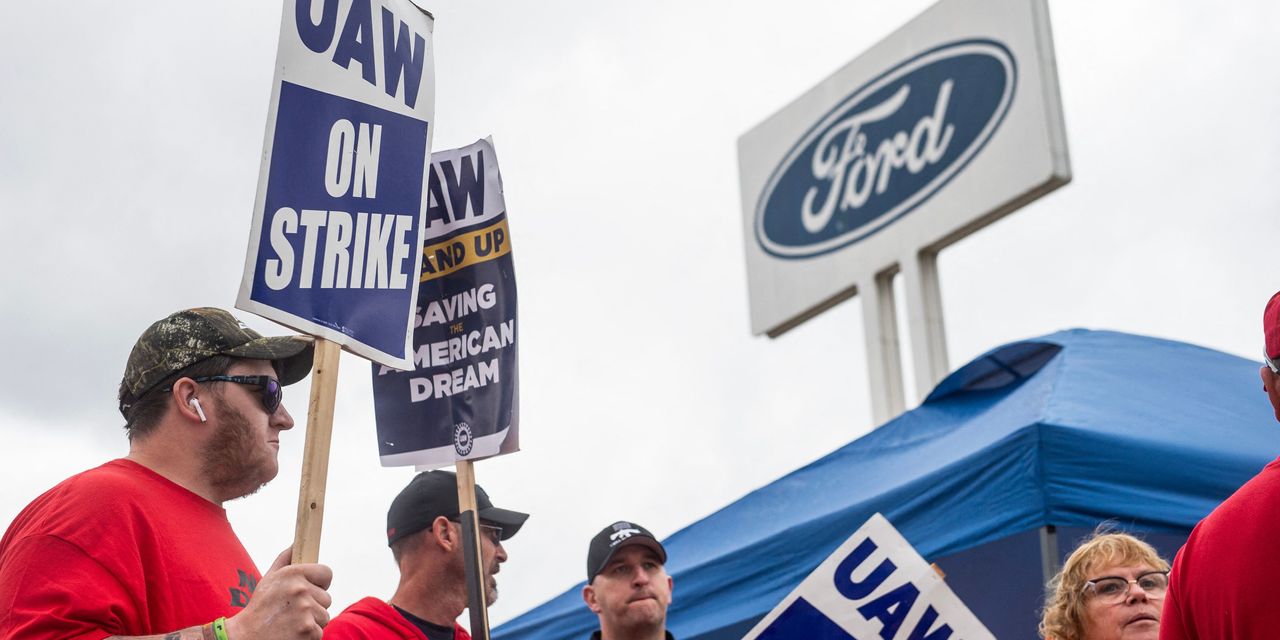Wall Street got busy Thursday calculating how much wage increases won by the striking United Auto Workers might weigh on the Big Three’s bottom lines.
Ford Motor Co.
F,
and the UAW announced a deal late Wednesday, with the union saying that base wages would rise by 25% through the life of the four-year contract.
The agreement would increase top wages at Ford by more than 30% to more than $40 an hour and push up starting wages by 68% to over $28 an hour once cost-of-living adjustments are factored in, the union said.
Ford workers are returning to their jobs while the tentative agreement goes through the ratification process, putting pressure on General Motors Co.
GM,
and Stellantis NV
STLA,
to also reach an agreement with the UAW.
Deutsche Bank analyst Emmanuel Rosner estimated a cost impact of around $850 million for Ford in the first year of the contract and of $2.3 billion by the fourth year, for a $6.2 billion cost increase over the four years of the contract.
See also: Ford earnings: What to expect from the carmaker after tentative agreement with UAW
Rosner estimated the impact for GM at around $1.2 billion in the first year and $2.5 billion in the fourth year, for a total of $7.2 billion. Stellantis would see an impact of about $1 billion in the first year, $2.2 billion in the fourth year and $6.4 billion total, the analyst said.
GM reported third-quarter earnings earlier this week and calculated a cost of about $800 million since the strike began in mid-September, including $600 million to be incurred in the fourth quarter.
The UAW broke with tradition of striking at only one carmaker at a time, instead calling for strikes at specific facilities of all three carmakers.
“Because the strike was spread out across all 3 [original equipment managers], unlike 2019 when UAW targeted GM, the impact is more modest for each OEM,” RBC Capital analyst Tom Narayan said in a note.
Some analysts expect that Ford, like GM, might withdraw its guidance for the year when it reports third-quarter earnings after the bell on Thursday.
But unlike GM, Ford has “the end in sight to enable the company to not pull its guidance,” Narayan said.
“As GM was on a trajectory toward the high end of their guidance excluding UAW impact, we expect [Ford] could lower its guidance by significantly less” than the $1 billion UAW impact, perhaps by up to $500 million, the analyst said.
The UAW-Ford tentative agreement “is a momentous victory for U.S. auto workers, which will have ripple effects on union organizing and bargaining efforts worldwide,” said Kate Bronfenbrenner, a lecturer at Cornell University’s School of Industrial and Labor Relations.
Their victory shows that “unions can win when they run aggressive and strategic strikes focusing on the issues that resonate with workers and the broader community,” Bronfenbrenner said in emailed comments.
Indeed, the UAW has set its sights on nonunionized car factories in the U.S., such as Tesla Inc.’s
TSLA,
and foreign automakers’ assembly plants.
During an address to the membership on Oct. 20, UAW President Shawn Fain vowed to intensify efforts to unionize at more car plants.
“We are going to organize nonunion auto companies like we’ve never organized before,” he said.
Meanwhile, shares of Ford, GM and Stellantis were in the red, tracking the broader equity markets. Losses were steeper for Tesla shares, down 3%, and for Rivian Automotive Inc.’s stock
RIVN,
down more than 5%.
Read the full article here










